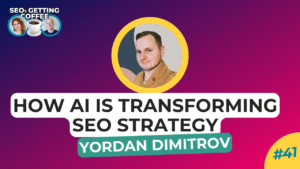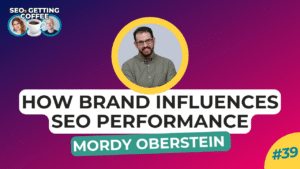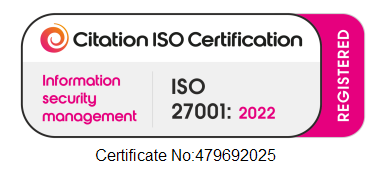In the modern world of digital content well-placed keywords and SEO tricks are not enough to stand out! It demands creating genuinely helpful content. But what exactly is “helpful content“?
In this week’s episode of SEOs is Getting Coffee, Sean and Emina are joined by Annika Haataja, SEO Director at Seeker Digital, who will bring her deep expertise in audience analysis and content marketing to the table and explore the importance of the relationship between the two.
Keep on reading to find out how her insights are not just about understanding what content works but why it works, and how businesses can leverage precise audience insights to supercharge their content strategies.
Watch Video
SEOs Getting Coffee - Episode #20: The Importance of Audience Analysis in Creating Helpful Content
What Is Helpful Content?
At its core, it’s about provide information that is immediately relevant and profoundly valuable to its intended audience. It means anticipating needs, answering real questions, and providing solutions that are both accessible and actionable. It’s the kind of content that not only attracts attention but retains it, transforming casual browsers into engaged readers and loyal followers.
The Role of Audience Analysis in Creating Impactful Content
Annika emphasises the significance of audience analysis as the cornerstone of developing helpful content. By delving into the specifics of what makes content resonate with readers, Annika provides a blueprint for transcending conventional SEO tactics to foster genuine connections with audiences. Understanding your audience involves more than gathering data—it’s about interpreting this data to gain profound insights into what motivates, concerns, and interests your audience. Here are some detailed approaches to enhancing your audience analysis:
- Psychographic Segmentation: Beyond basic demographics, psychographic segmentation involves understanding the psychological attributes of your audience, such as personality, values, opinions, and lifestyles. This information can be used to create content that aligns with the intrinsic motivations that drive audience behaviour.
- Sentiment Analysis: Employ sentiment analysis tools to assess the emotions behind audience interactions on social media and comments on your content. Understanding whether the sentiment is positive, negative, or neutral can help tailor your messaging to better address audience feelings and increase engagement.
- User Feedback and Community Engagement: Direct interaction with your audience through comments, forums, and social media platforms can provide unfiltered feedback on their needs and content preferences. Engaging with your audience in these ways not only helps to build a community around your content but also deepens your understanding of their ongoing interests and concerns.
Key Strategies for Enhancing Content through Audience Analysis
Creating genuinely helpful content involves more than the standard SEO playbook. It requires deep research into who your audience really is what are their pain points, what stage of life they are in and what they need from you. Below are enriched strategies, inspired by Annika, to leverage audience analysis in enhancing content effectively.
- Expanding Research Beyond Keywords: Understanding the audience’s deeper needs goes beyond mere keyword research. Engaging with social media insights, user-generated content on platforms like Reddit, and direct feedback from forums can uncover what the audience truly cares about.
- Integrating Google’s People-First Guidelines: Google’s shift towards rewarding people-first content underscores the need to align content strategies with the goal of adding real value. Annika advocates for content that addresses the user’s intent and provides substantive answers to their queries. Platforms such as Reddit and Quora are goldmines for understanding audience questions, concerns, and the language they use. This can help tailor content that speaks directly to their queries and needs.
- Understanding the Human Element: Successful content marketing hinges on an empathetic approach to audience profiles—not just viewing them as demographic data but as real people with specific needs and pain points. Reflect on the challenges, pain points, and aspirations of your audience. Tailor your content to not only inform but also inspire and reassure, building a connection that fosters loyalty.
Navigating the Challenges of Content Strategy
Annika discusses practical challenges faced in content creation, particularly the balancing act between optimising for search engines and enhancing user experience. She shares innovative solutions to these challenges:
- Balancing SEO and Audience Relevance: Striking a balance between SEO requirements and genuine audience engagement is crucial. Annika suggests innovative ways to incorporate SEO elements without compromising the integrity of the content.
- Diversifying Content Formats: Recognising that different segments of an audience may prefer different content formats—such as videos, infographics, or podcasts—can significantly boost engagement by catering to varied preferences
The Role of Personas in Audience Analysis
In the discussion, Emina Demiri-Watson and Annika Haataja explore the benefits and limitations of personas in content marketing. Emina emphasises the importance of understanding the audience deeply, suggesting that marketers review tools, participate in demos, and collaborate with sales teams to gain insights into customer goals and pain points. This holistic approach can enhance audience analysis and improve marketing strategies.
Annika acknowledges the mixed opinions on personas, noting that while they can provide a useful baseline, they can also be limiting if used in isolation. She highlights the importance of not making assumptions based solely on demographics like age or professional background. Instead, understanding the customer’s journey and avoiding the bias of projecting personal experiences onto the audience is crucial. She stresses that deep audience analysis should inform the creation and optimization of content across various touchpoints.
Overall, the conversation underscores the need for a nuanced and comprehensive approach to audience analysis beyond just personas, ensuring that marketing efforts are truly aligned with diverse customer needs and behaviors.
Identifying Emerging Trends and Questions
Sean Carroll brings up the importance of identifying emerging questions or themes developing within your audience, beyond just relying on existing keyword research data. He points out that emerging topics may not yet have much search volume, but pinpointing them allows you to get ahead of new trends.
Annika Haataja provides some advice on how to identify these emerging topics:
- Listen to customer service/support teams who receive feedback, questions and complaints from customers that may reveal unaddressed needs or use cases.
- Analyze product reviews, using tools to scrape and run sentiment analysis to surface frequently mentioned pain points or interests. These may be very specific issues not captured in typical keyword research.
- Pay attention to what your existing audience is already struggling with, as there are likely others with the same problems who haven’t thought to search for solutions yet.
The key is tapping into sources like support interactions, reviews, and observing your current audience to uncover emerging themes and questions to address in your content before others. This allows you to get ahead of new trends rather than just following existing search data.
Banishing AI-Generated Content Discussions to Room 404
In the “Room 404” segment of the podcast, Annika Haataja expressed her desire to banish the ongoing conversation surrounding AI-generated content to Room 404 (or perhaps Room 410, as Emina jokingly suggested). Annika conveyed her frustration with the repetitive discussions and case studies circulating on social media about using AI to generate website content, often accompanied by caveats advising against doing so for sites one truly values.
Annika has argued that this whole thing is fast becoming a big time-waster, particularly for new SEOs who find it confusing and distract from more productive things. She noted the importance of human involvement in the making of content, with AI in use merely as a tool to help and assist in the creation process; through the content, human empathy, compassion, and understanding will shine to be able to resonate with audiences. Annika insisted that the content debate around AI is a red herring and that it is high time we moved past the straw man to the nuances of using AI in responsible ways that genuinely beef up human-driven strategies
Conclusion: Building a Bridge to Your Audience
This insightful episode with Annika Haataja underscores a pivotal shift in content marketing—from keyword-focused strategies to a holistic, audience-first approach. By truly understanding and addressing the needs of our audience, we not only enhance our SEO efforts but also build lasting relationships with our readers.
For more insights and in-depth conversations on the latest in SEO and digital marketing strategies, stay stuned for upcoming episodes of “SEOs Getting Coffee.” Subscribe to our channel for regular updates and expert opinions.












